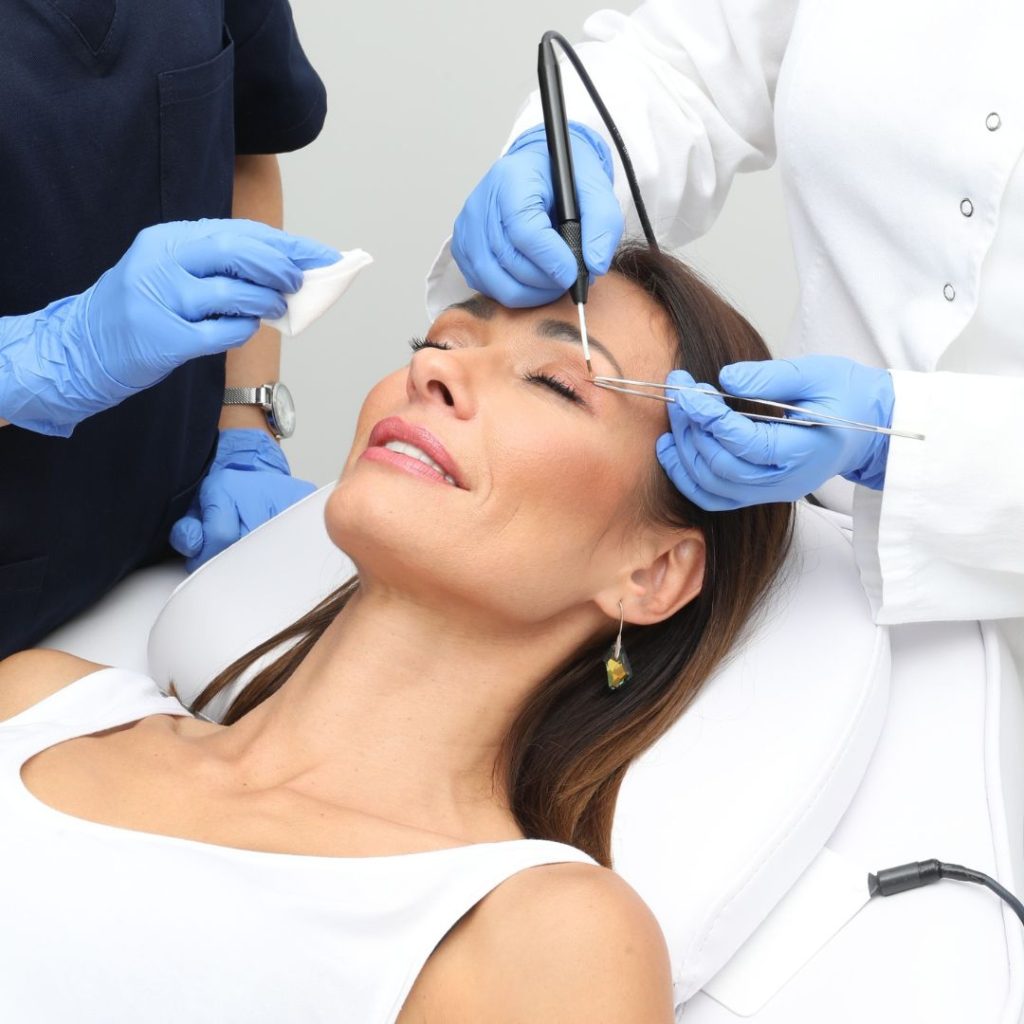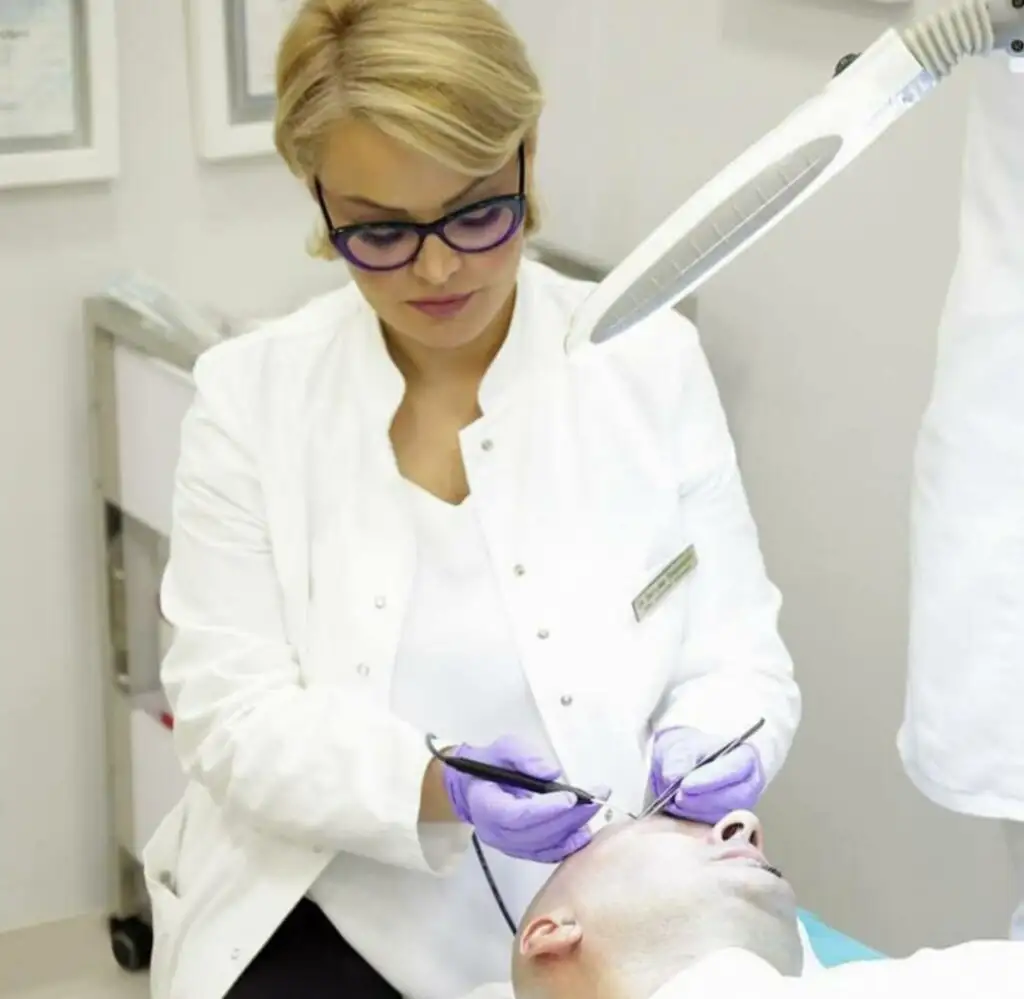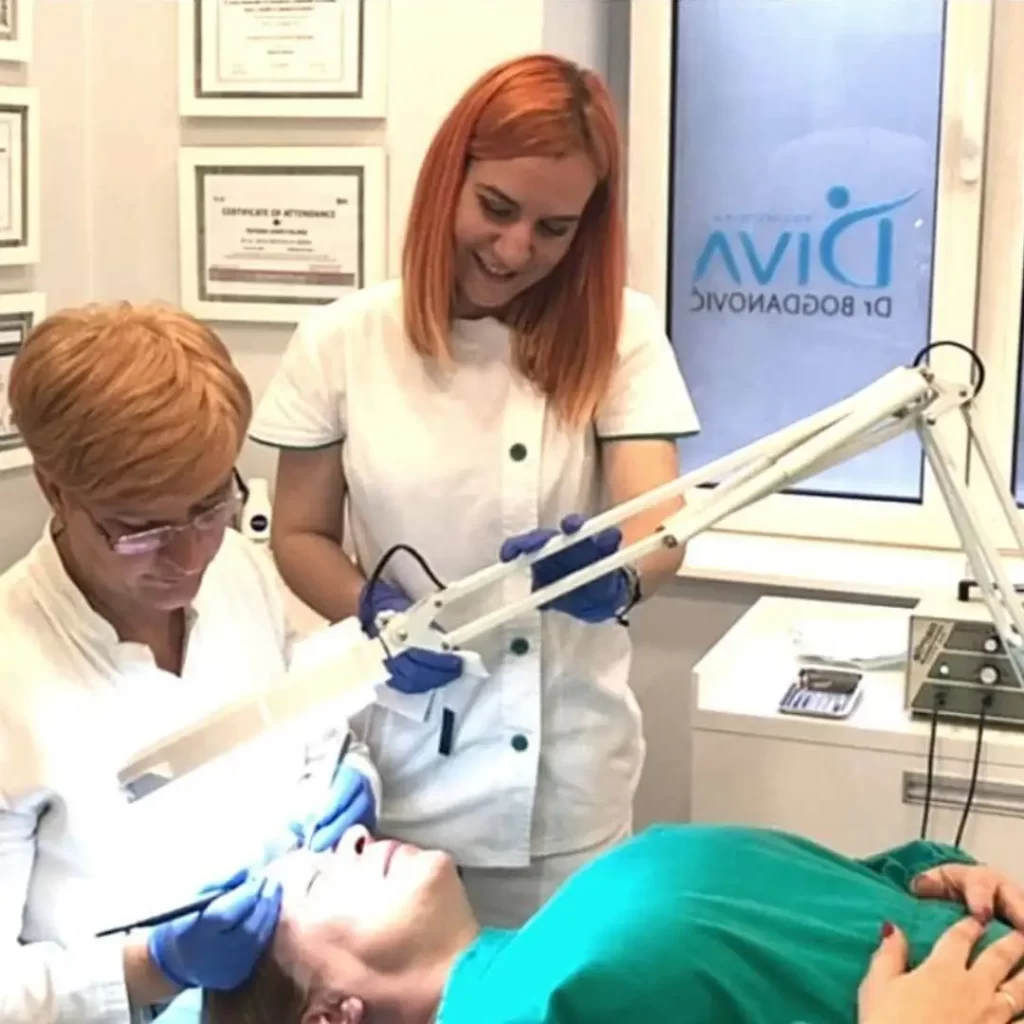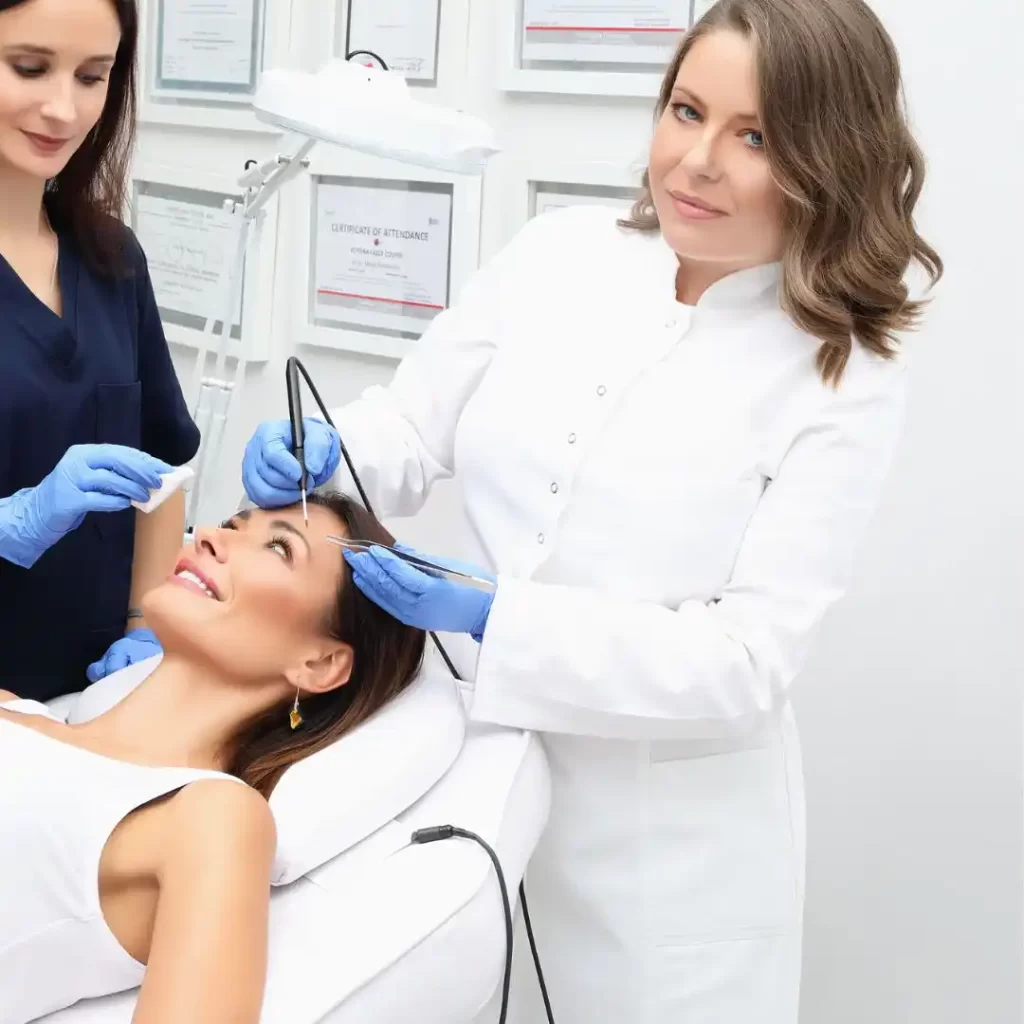A free examination by a specialist in dermatology or cosmetic surgery should be scheduled if you notice any changes in xanthelasma. That is, if they change color, shape or size.
The same applies if the xanthelasma are located in a place of constant irritation, are injured or itchy.

Based on the examination, our doctor assesses whether it is necessary:
- removal of xanthelasma by radio wave technique or
- by the classic surgical method.
Of course, it is possible to schedule xanthelasma removal for aesthetic reasons as well.
Free consultation for the removal of xanthelasma at the Diva Polyclinic
You can schedule a FREE consultation for the removal of xanthelasma in Belgrade with the doctors of the polyclinic Diva Dr. Bogdanović in one of our polyclinics or specialist dermatology offices:
What are xanthelasmas?
Xanthelasma are noticeable yellowish-white deposits in the form of plates around the eyes, that is, on the eyelids. They can be slightly raised above the skin or flat. They are soft to the touch.
Their area is clearly limited. Their shape is round or oval.
Xanthelasma are localized groups of giant foamy cells (macrophages) and lipids (fat), and are benign growths on the skin.
Where do xanthelasmas occur?
In most cases, they appear in the inner corners of the eyelids – the inner corner of the eye (upper or lower eyelids).
Why is xanthelasma removal recommended?
The first reason for removing xanthelasma is aesthetic, because they generally do not affect the functioning of the eye region.
Another reason for removing them is because, although slow, they tend to grow. Often, their number increases over time, which can lead to their merging. In that case, when they cover a larger area, they become more noticeable.


How can xanthelasma be removed?
Treatment can be carried out:
- Radio wave method
- By surgical method
And the optimal method for removing xanthelasma from 2 to 8 mm in size is the radio-wave technique. Regardless of whether they are on the upper or lower eyelids,
If the changes are larger than 8 mm and, for example, spread over the entire eyelids, then the surgical method of xanthelasma removal is applied.
Which procedure is adequate to remove xanthelasma?
To get rid of xanthelasma optimalni su radio-talasi. Ovo važi i za sve intervencije u regiji oko očiju (na očnim kapcima).
Radiowave surgery is an extremely sophisticated, modern surgical method for removing benign skin changes. It is widely used in plastic surgery and dermatosurgery. This is because in these branches of medicine it is very important to get as fine and almost imperceptible a scar as possible.
What are the advantages of xanthelasma removal with radio waves?
When xanthelasma is removed in this way:
- 1 intervention is enough,
- it is comfortable (a local anesthetic in the form of a cream is used),
- efficiently and
- quickly.
How many treatments are needed to remove them?
Xanthelasma are removed in one intervention. It usually lasts from 2 to 3 minutes.
It is comfortable for the patient because a local anesthetic in the form of a cream is used. After the procedure, barely noticeable fine scars may remain.
However, if they are larger than 8 mm and cover larger areas, a surgical method of xanthelasma removal is recommended.

What does the procedure for removing xanthelasma with the radio wave method look like at the Diva Polyclinic?
First, a specialist doctor performs a clinical examination. Then a local anesthetic in the form of a cream is applied to the site where the xanthelasma is located. Then radio waves are used to remove the change from the skin.
What does recovery look like after this procedure?
After the intervention, sores are present in the treated region. Scabs are later formed on them (epithelialization period). They fall off within 7 to 10 days.
Due to the fact that the radio-wave technique is very sophisticated, there may be barely noticeable scars. It all depends on skin type, age, genetics, hormonal status and lifestyle.
Who performs the xanthelasma removal procedure at Diva Polyclinic?
Exclusively specialist doctors with more than 25 years of experience in radiosurgery, led by aesthetic surgeon Dr. Spec. Svetlana Bogdanović.
How is the diagnosis made before the procedure to remove xanthelasma is applied?
In most cases, it is sufficient for a specialist doctor to perform a clinical examination. When necessary, a dermoscopy can be performed additionally.
Patients are advised to have biochemical analyzes when xanthelasma appear. The reason for this is to determine the level of fat in the blood. If there is a need for it, additional therapies are prescribed.

Why do xanthelasmas occur - what are the causes?
Previously, it was believed that the cause of the formation of xanthelasma was solely an increased level of cholesterol in the blood and a disorder of fat metabolism. However, it has been shown that there is no direct cause-and-effect relationship, as almost half of patients with xanthelasma do not have elevated blood cholesterol or lipid levels.
Xanthelasma also occur in people who do not have disorders of fat metabolism or elevated cholesterol. That’s why it was concluded that the genetic factor plays a big role.
What do xanthelasmas look like?
Changes in the angle of the eyelids are:
- usually plate-shaped,
- soft to the touch,
- occur in the inner corner of the eye,
- have a tendency to grow and merge multiple xanthelasma into one growth on the skin,
- they are often yellowish-white in color,
- they can appear on both the upper and lower eyelids,
- they do not impair the function of the eyelids.
When do xanthelasmas appear?
These skin growths occur more often in men than in women. Although they can occur throughout life, these changes usually occur during the fourth and fifth decades.
Can xanthelasma reappear on the eyelids after removal?
Depending on the overall state of the organism, lifestyle habits, genetics and diet, xanthelasma, unfortunately, can reappear on or under the eyelids.
In order to prevent the recurrence of xanthelasma, doctors advise a healthy diet, avoiding smoking, physical activity and regular control of blood fat levels.
Are xanthelasma dangerous to health?
Considering that they belong to benign changes on the skin, that they are not painful and that they usually do not disturb the function of the eyelids, it is considered that the reason for their removal is mainly aesthetic.
However, in rare cases, their sudden growth may occur. Then they can affect the lowering of the eyelid. When this happens, as the eyelids cover the pupils, they obstruct vision.
Xanthelasma removal - price
NOTE:
Whether radio waves are an adequate method for removing xanthelasma will be assessed by a specialist doctor during a free consultation.
The results of the procedure may vary from patient to patient, and this is influenced by factors such as skin type, i.e. whether it is prone to scar tissue formation.
You can read the entire disclaimer HERE.
Appointment for a free examination of xanthelasma or a procedure to remove xanthelasma in Belgrade
At the polyclinic Diva Dr. Bogdanović Belgrade, with our doctors specializing in dermatology and aesthetic surgery, you can schedule a FREE consultation for examination and removal of xanthelasma in one of our polyclinics or specialist dermatology offices:
to one of the phone numbers 063 338 334 or 011 3242 841 or to the email info@divaclinic.com
Our specialist doctors will tell you during the examination what kind of results you can expect after this procedure.
You can schedule an examination or procedure
· every working day from 9 a.m. to 8 p.m
· and on Saturdays from 9 a.m. to 3 p.m.
Price for specialist dermatological skin examination and dermoscopic examination of moles
If a specialist dermatological examination of the skin is required due to dermatological changes on the skin, then the price is RSD 6,000.
If you want to schedule only a dermoscopic mole examination, the price is RSD 6,000.
Your “Polyclinic Diva”
Author of the text: Dr. spec. Svetlana Bogdanović
Koautor: dr spec. Marija Šejnjanović


